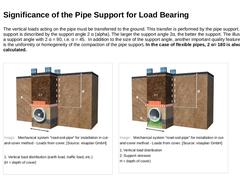
|
The vertical loads acting on the pipe must be transferred to the ground. This transfer is performed by the pipe support. The pipe support is described by the support angle 2 α (alpha). The larger the support angle 2α, the better the support. The illustration shows a support angle with 2 α = 90, i.e. α = 45. In addition to the size of the support angle, another important quality feature of the support is the uniformity or homogeneity of the compaction … |
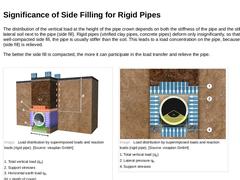
|
The distribution of the vertical load at the height of the pipe crown depends on both the stiffness of the pipe and the stiffness of the of lateral soil next to the pipe (side fill). Rigid pipes (vitrified clay pipes, concrete pipes) deform only insignificantly, so that even with well-compacted side fill, the pipe is usually stiffer than the soil. This leads to a load concentration on the pipe, because the lateral soil (side fill) is relieved. The … |
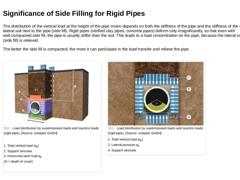
|
The distribution of the vertical load at the height of the pipe crown depends on both the stiffness of the pipe and the stiffness of the of lateral soil next to the pipe (side fill). Rigid pipes (vitrified clay pipes, concrete pipes) deform only insignificantly, so that even with well-compacted side fill, the pipe is usually stiffer than the soil. This leads to a load concentration on the pipe, because the lateral soil (side fill) is relieved. The … |
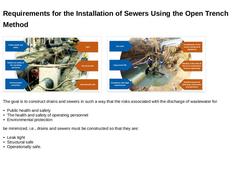
|
(Image: Requirements for the installation of sewers in open trench - Background image shows an unprofessional installation of a sewer in open trench - Requirements are not met) (Image: Requirements for the installation of sewers in open trench - Background image shows an unprofessional installation of a sewer in open trench - Requirements are not met - Image 2) The goal is to construct pipelines in such a way that the risks associated with the transportation … |
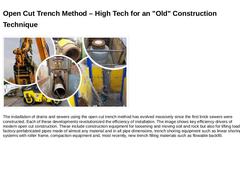
|
(Image: Open cut trench method - High tech for an "old" construction method) The installation of pipelines using the open cut trench method has evolved massively since the first brick sewers were constructed. Each of these developments revolutionized the efficiency of installation. The image shows key efficiency drivers of modern open cut construction. These include construction equipment for loosening and moving soil and rock but also for lifting … |
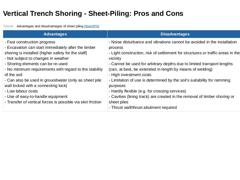
|
(Table: Advantages and disadvantages of sheet piling) |
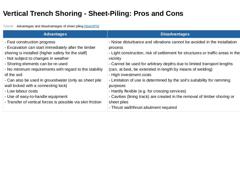
|
(Table: Advantages and disadvantages of sheet piling) |
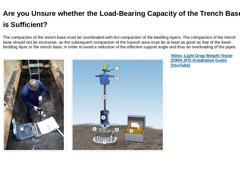
|
The compaction of the trench base must be coordinated with the compaction of the bedding layers. The compaction of the trench base should not be excessive, as the subsequent compaction of the haunch area must be at least as good as that of the lower bedding layer or the trench base, in order to avoid a reduction of the effective support angle and thus an overloading of the pipes. (Image: Verification of the bearing capacity of the trench base by means … |
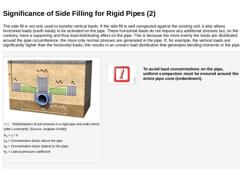
|
The side fill is not only used to transfer vertical loads. If the side fill is well compacted against the existing soil, it also allows horizontal loads (earth loads) to be activated on the pipe. These horizontal loads do not impose any additional stresses but, on the contrary, have a supporting and thus load-distributing effect on the pipe. This is because the more evenly the loads are distributed around the pipe circumference, the more only normal … |
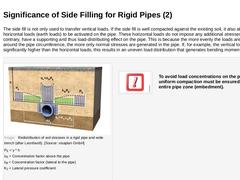
|
The side fill is not only used to transfer vertical loads. If the side fill is well compacted against the existing soil, it also allows horizontal loads (earth loads) to be activated on the pipe. These horizontal loads do not impose any additional stresses but, on the contrary, have a supporting and thus load-distributing effect on the pipe. This is because the more evenly the loads are distributed around the pipe circumference, the more only normal … |
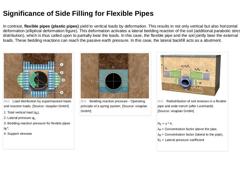
|
In contrast, flexible pipes (plastic pipes) yield to vertical loads by deformation. This results in not only vertical but also horizontal deformation (elliptical deformation figure). This deformation activates a lateral bedding reaction of the soil (additional parabolic stress distribution), which is thus called upon to partially bear the loads. In this case, the flexible pipe and the soil jointly bear the external loads. These bedding reactions … |
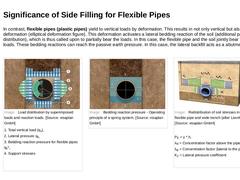
|
In contrast, flexible pipes (plastic pipes) yield to vertical loads by deformation. This results in not only vertical but also horizontal deformation (elliptical deformation figure). This deformation activates a lateral bedding reaction of the soil (additional parabolic stress distribution), which is thus called upon to partially bear the loads. In this case, the flexible pipe and the soil jointly bear the external loads. These bedding reactions … |
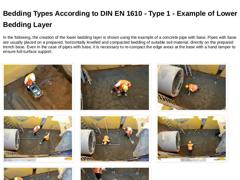
|
In the following, the creation of the lower bedding layer is shown using the example of a concrete pipe with base. Pipes with base are usually placed on a prepared, horizontally levelled and compacted bedding of suitable soil material, directly on the prepared trench base. Even in the case of pipes with base, it is necessary to re-compact the edge areas at the base with a hand tamper to ensure full-surface support. (Image: Preparation of the lower … |
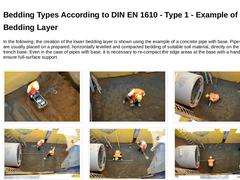
|
In the following, the creation of the lower bedding layer is shown using the example of a concrete pipe with base. Pipes with base are usually placed on a prepared, horizontally levelled and compacted bedding of suitable soil material, directly on the prepared trench base. Even in the case of pipes with base, it is necessary to re-compact the edge areas at the base with a hand tamper to ensure full-surface support. (Image: Preparation of the lower … |
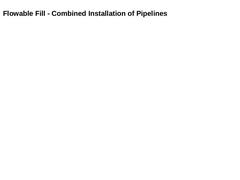
|
Hydraulically bound backfill materials are particularly suitable for the combined installation of pipes and sewers. With conventional installation of pipelines, sufficient minimum distances are required for the necessary compaction of the soil. These are not required when installing the pipes with hydraulically bound backfill materials. The following pictures show a corresponding application. Reinforced concrete elements are used as installation aids. … |
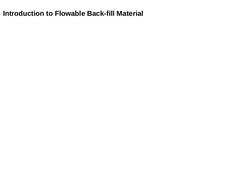
|
(Video: Bert Bosseler Open-cut method Soil and Components Flowable Back-Fill Material) |
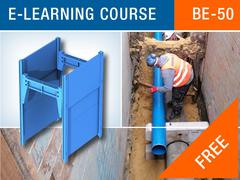
|
This course features elements relevant to amongst others the European continent. This course includes neither tutorial services nor a final examination. This course is available free of charge. To access it, please register on UNITRACC.com.
----------------------- The most common method utilized worldwide for pipeline installation is the open cut method. This is especially true for gravity pipelines. While, at first glance, the open cut method seems to be a "simple" constructon method, it becomes highly complex when used in urban areas and at large depths. This course is divided into two parts: - The first part is focused on important technical knowledge on securing the trench and making it a safe work zone. It presents the many options available in this regard.
- The second part is focused on the correct pipeline installation techniques including backfilling of the trench and the removal of the shoring.
The net learning time is approx. 3 days. |
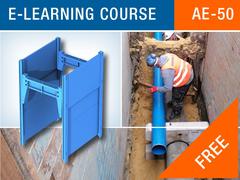
|
This course features elements relevant to amongst others the North-American continent. This course includes neither tutorial services nor a final examination. This course is available free of charge. To access it, please register on UNITRACC.com.
----------------------------- The most common method utilized worldwide for pipeline installation is the open cut method. This is especially true for gravity pipelines. While, at first glance, the open cut method seems to be a "simple" constructon method, it becomes highly complex when used in urban areas and at large depths. This course is divided into two parts: - The first part is focused on important technical knowledge on securing the trench and making it a safe work zone. It presents the many options available in this regard.
- The second part is focused on the correct pipeline installation techniques including backfilling of the trench and the removal of the shoring.
The net learning time is approx. 3 days. |
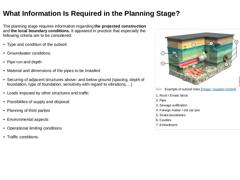
|
(Image: Example of subsoil risks) The planning stage requires information regarding the projected construction and the local boundary conditions. It appeared in practice that especially the following criteria are to be considered: -
Type and condition of the subsoil
-
Groundwater conditions
-
Pipe run and depth
-
Material and dimensions of the pipes to be installed
-
Securing of adjacent structures above- and below ground (spacing, depth of foundation, …
|
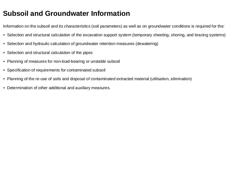
|
Information on the subsoil and its characteristics (soil parameters) as well as on groundwater conditions is required for the: -
Selection and structural calculation of the excavation support system (temporary sheeting, shoring, and bracing systems)
-
Selection and hydraulic calculation of groundwater retention measures (dewatering)
-
Selection and structural calculation of the pipes
-
Planning of measures for non-load-bearing or unstable subsoil
-
Specification …
|
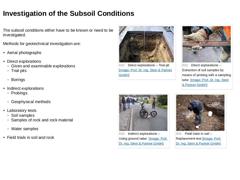
|
The subsoil conditions either have to be known or need to be investigated. Methods for geotechnical investigation are: -
Aerial photographs
-
Direct explorations
-
Given and examinable explorations
-
Trial pits
-
Borings
-
Indirect explorations
-
Probings
-
Geophysical methods
-
Laboratory tests
-
Soil samples
-
Samples of rock and rock material
-
Water samples
-
Field trials in soil and rock
(Image: Direct explorations – Trial pit) (Image: Direct explorations – … |
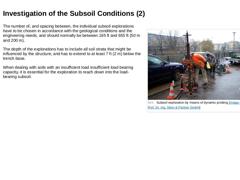
|
(Image: Subsoil exploration by means of dynamic probing) The number of, and spacing between, the individual subsoil explorations have to be chosen in accordance with the geological conditions and the engineering needs, and should normally be between 165 ft and 655 ft (50 m and 200 m). The depth of the explorations has to include all soil strata that might be influenced by the structure, and has to extend to at least 7 ft (2 m) below the trench base. |
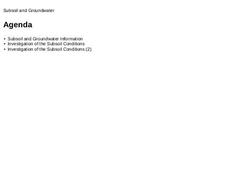
|
|
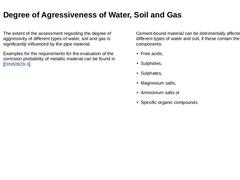
|
The extent of the assessment regarding the degree of aggressivity of different types of water, soil and gas is significantly influenced by the pipe material. Examples for the requirements for the evaluation of the corrosion probability of metallic material can be found in [ [DIN50929-3]]. Cement-bound material can be detrimentally affected by different types of water and soil, if these contain the following components: -
Free acids,
-
Sulphides,
-
Sulphates,
|
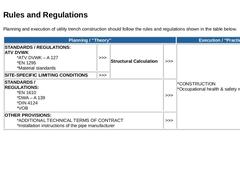
|
Planning and execution of utility trench construction should follow the rules and regulations shown in the table below. |
Planning / “Theory” |
Execution / “Practice” |
|---|
|
STANDARDS / REGULATIONS: ATV DVWK *ATV DVWK – A 127 *EN 1295 *Material standards |
>>> |
Structural Calculation |
>>> |
*CONSTRUCTION *Occupational health & safety regulations |
|
SITE-SPECIFIC LIMITING CONDITIONS |
>>> |
|
STANDARDS /
REGULATIONS: *EN 1610 *DWA – A 139 *DIN 4124 *VOB |
>>> |
|
OTHER PROVISIONS: |
|